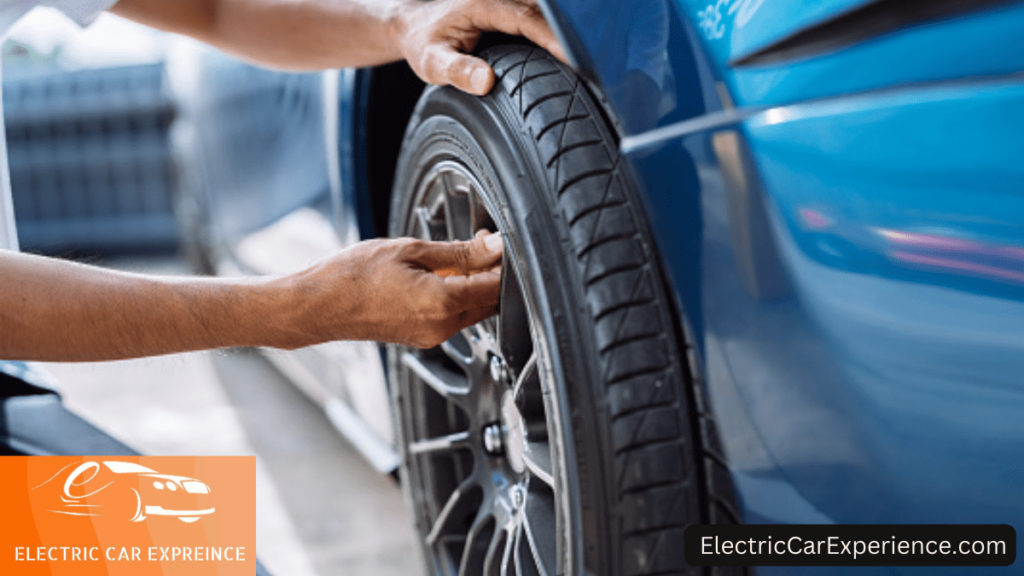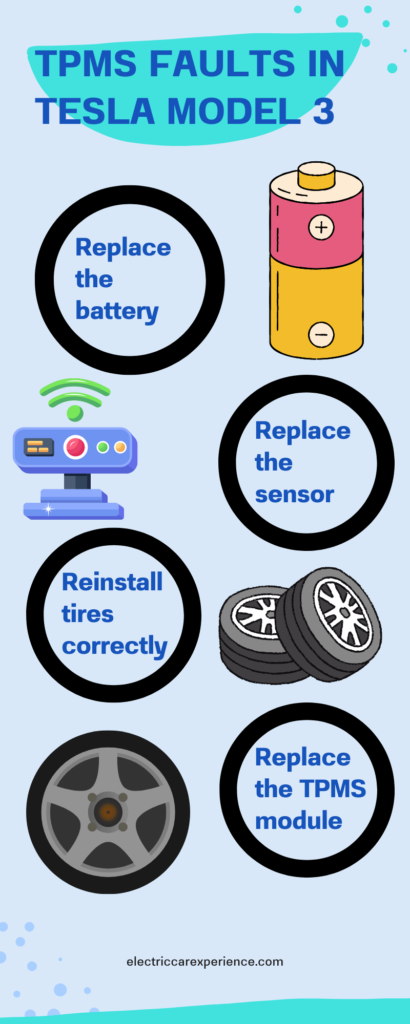
The Tire Pressure Monitoring System (TPMS) in Tesla Model 3 is designed to monitor the air pressure in each tire and alert the driver if there is a significant drop in pressure, which can lead to reduced fuel efficiency, uneven tire wear, and unsafe driving conditions.
There are a number of potential causes and fixes to think about if your Tire Pressure Monitoring System Fault in Tesla Model 3:
- Verify the tire pressure: Make sure that the required tire pressure for your Tesla Model 3 is applied to all of your tires. A TPMS issue could occur if any of your tires are considerably underinflated.
- Test the TPMS sensors: Your Tesla Model 3’s TPMS sensors may have developed a problem and resulted in the issue. To have the sensors inspected and, if necessary, changed, get in touch with the Tesla service location closest to you.
- Start the car again: In some cases, TPMS error codes can be cleared by just restarting the car. To check if the issue is resolved, turn off and then back on the automobile.
- For software upgrades, check: Your Tesla Model 3 might be eligible for a software update that fixes TPMS problems. For assistance, check your Tesla account for updates or get in touch with the local Tesla service center.
It is advised to get in touch with Tesla customer support or make an appointment with a Tesla service center for additional evaluation and repair if none of these fixes your Tesla Model 3’s TPMS issue.
[toc]
Introduction to Tire Pressure Monitoring System Fault In Tesla Model 3
The Tesla Model 3 has a safety feature called the Tire Pressure Monitoring System (TPMS) that helps track the air pressure in each tire and notifies the driver if there is a substantial drop in pressure. By ensuring that the tires are correctly inflated and operating as intended, the system aims to increase safety, fuel efficiency, and tire life.
The Tesla Model 3’s TPMS is made up of sensors that are fitted inside each tire and a receiver that is housed in the onboard computer. The sensors take tire pressure and temperature readings and wirelessly communicate them to the receiver.
Types of TPMS
| Type of TPMS | Description |
|---|---|
| Direct | Sensors are mounted inside each tire, which transmit data wirelessly to the vehicle’s onboard computer. |
| Indirect | Measures tire pressure by monitoring wheel speed and other parameters, such as temperature and rolling radius. |
| Hybrid | Combines elements of direct and indirect systems to provide more accurate monitoring. |
With this knowledge, the onboard computer can determine the tire pressure and notify the driver if there is a significant drop in pressure or a problem with the system.
The TPMS in the Tesla Model 3 is made to abide by Federal Motor Vehicle Safety Standard 138 (FMVSS 138), which mandates the installation of a TPMS system in all new cars to warn the driver of low tire pressure situations.
The Tesla Model 3’s TPMS assists in ensuring peak performance, safety, and efficiency while lowering the possibility of tire-related mishaps and vehicle damage by keeping an eye on tire pressure and temperature.
Recommended tire pressure for common types of vehicles
| Vehicle Type | Recommended Tire Pressure (psi) |
|---|---|
| Sedan | 32-35 |
| SUV | 35-40 |
| Pickup Truck | 35-40 |
| Sports Car | 30-35 |
Understanding TPMS Faults in Tesla Model 3
When the Tesla Model 3’s TPMS fails, there is a problem with the system. This problem could be brought on by a number of things, including damaged or malfunctioning sensors, low battery levels, wiring problems, or a breakdown in communication between the sensor and the onboard computer.
The driver will be informed to check the tire pressure or have the TPMS system repaired when a TPMS issue is discovered via a warning message that will appear on the dashboard display of the vehicle.
A warning message for low tire pressure and a fault message for a TPMS system issue are the two different sorts of TPMS faults that can happen in the Tesla Model 3.

The most common reason for a low tire pressure warning sign is an actual drop in tire pressure, which can be fixed by pumping up the tire to the recommended pressure. A fault notice for a TPMS system malfunction, on the other hand, denotes a problem with the system that needs additional investigation and repair.
The fact that TPMS errors can occur even when the tire pressure is within the authorized range must be noted. This can be caused by a sensor problem or other systemic problems. The TPMS problem alert in these circumstances needs to be taken seriously and attended to right away to ensure the system is operating properly.
Recommended Tire Pressures for a Tesla Model 3
| Tire Type | Tire Size | Recommended Tire Pressure |
|---|---|---|
| Front | 235/45R18 | 42 psi |
| Rear | 235/45R18 | 42 psi |
| Front | 235/40R19 | 45 psi |
| Rear | 235/40R19 | 45 psi |
Common Causes of TPMS Faults in Tesla Model 3
When a tire’s pressure is either too low or too high, the Tesla Model 3’s Tire Pressure Monitoring System (TPMS) is supposed to inform the driver. Below are a few typical reasons why a Tesla Model 3’s TPMS might malfunction:
- Low tire pressure: One of the most common causes of TPMS faults is low tire pressure. If the pressure in one or more of your tires is too low, the TPMS sensor will detect this and trigger a warning on your dashboard.
- Dead or low battery: The TPMS sensor in your Tesla Model 3 relies on a battery to function. If the battery is dead or low, the TPMS may not be able to send accurate information to the car’s computer, which can result in a fault.
- Sensor damage: The TPMS sensors in your Tesla Model 3 are located inside the tires and can be damaged by road debris, potholes, or other hazards. If a sensor is damaged, it may not be able to send accurate information to the car’s computer, which can cause a TPMS fault.
- Incorrect tire installation: If your tires are not installed correctly, it can cause a TPMS fault. For example, if a tire is installed with the wrong orientation, or if the valve stem is not properly aligned, the TPMS sensor may not be able to read the tire’s pressure accurately.
- Malfunctioning TPMS module: In rare cases, the TPMS module in your Tesla Model 3 may malfunction, which can cause a TPMS fault. If you have checked all of the above issues and the TPMS is still not working correctly, it may be necessary to replace the TPMS module.
How to Fix TPMS Faults in Tesla Model 3

If you have performed troubleshooting steps and determined that there is a problem with the TPMS system in your Tesla Model 3, here are some steps you can take to fix the issue:
- Replace the battery: If the TPMS sensor’s battery is dead or low, replacing the battery may fix the issue. You can either replace the battery yourself or take your car to a Tesla Service Center for assistance.
- Replace the sensor: If the TPMS sensor is damaged, it may need to be replaced. You can order replacement sensors from Tesla or a third-party supplier, or take your car to a Tesla Service Center for assistance.
- Reinstall tires correctly: If the TPMS fault is caused by incorrect tire installation, you will need to reinstall the tires correctly. Make sure the tires are installed with the correct orientation and that the valve stems are properly aligned.
- Replace the TPMS module: If the TPMS fault is caused by a malfunctioning TPMS module, it will need to be replaced. You can order a replacement module from Tesla or take your car to a Tesla Service Center for assistance.
Note that fixing TPMS faults in a Tesla Model 3 can be complex, and it’s recommended that you seek assistance from a Tesla-certified technician if you’re unsure of how to proceed.
Importance of Addressing TPMS Faults in Tesla Model 3
It’s critical to fix TPMS issues in the Tesla Model 3 for a number of reasons.
A TPMS issue can, in the first place, jeopardize the safety of the car and its occupants. The likelihood of a tire blowout, which can cause a major accident, increases with a considerable reduction in tire pressure. This can also cause poor handling and an increase in stopping distance. Potential safety risks can be avoided by the driver by checking the tire pressure or having the TPMS system serviced after receiving a TPMS fault warning.
Second, fixing TPMS issues can assist reduce tire wear and increase fuel efficiency. If the tire pressure is too low, the tire may wear out more quickly and the car’s fuel efficiency may suffer. Drivers can keep their tires inflated to the recommended pressure, prolong the life of their tires, and achieve maximum fuel efficiency by swiftly fixing TPMS issues.

Last but not least, fixing TPMS issues might help avoid future, more serious, pricey repairs. If the TPMS problem is not fixed, it may lead to problems with the brakes or the suspension system, which could cost money to fix. Drivers can maintain their Tesla Model 3 functioning smoothly and prevent more serious problems by fixing TPMS failures as soon as they appear.
In conclusion, fixing TPMS issues in the Tesla Model 3 is essential for long-term maintenance, safety, and fuel efficiency.
TPMS Fault Symptoms in a Tesla Model 3
| Symptom | Description |
|---|---|
| Low tire pressure warning light | The TPMS system detects low tire pressure and triggers a warning light on the car’s dashboard. |
| High tire pressure warning | The TPMS system detects high tire pressure and triggers a warning light on the car’s dashboard. |
| Erroneous tire pressure reading | The TPMS system displays an incorrect tire pressure reading on the car’s dashboard or touchscreen. |
Advantages of TPMS
- Alerts drivers to low tire pressure or other issues
- Helps prevent tire wear and tear
- Improves fuel efficiency and vehicle handling
- Provides real-time tire pressure readings
- Enhances vehicle safety by reducing the risk of accidents
Disadvantages of TPMS
- Can be expensive to repair or replace components if there are issues
- Can trigger false alarms if sensors are not installed correctly or if battery voltage is low
- May require calibration after tire rotation or replacement, which can be time-consuming
- Not all tire pressure issues are detected by the system, such as slow leaks or punctures
- Can be less accurate than manually checking tire pressure with a gauge
Conclusion
In conclusion, the Tesla Model 3’s Tire Pressure Monitoring System (TPMS) is a crucial safety feature that works to keep track of each tire’s air pressure and warns the driver if there is a sudden drop in pressure.
There are a number of things that can go wrong with sensors, have a low battery, affect wiring, or result in communication faults that can lead to TPMS problems in the Tesla Model 3. To maintain vehicle safety and proper operation, TPMS issues must be fixed very away. Tire pressure checks, vehicle restarts, software update checks, and contacting a Tesla service center for additional diagnosis and repair are all possible ways to troubleshoot TPMS issues. Your Tesla Model 3 can operate safely and effectively with regular TPMS system maintenance and inspection, which can help prevent malfunctions.
FAQs
Does the TPMS Problem Have a Warranty?
The TPMS issue ought to be covered by warranty if your Tesla Model 3 is still under it. To be certain, it’s crucial to review the details of your warranty. You could have to pay for repairs out of pocket if the warranty has already run out.
Is it safe to operate my Tesla Model 3 while the TPMS is broken?
Although it is usually safe to drive with a TPMS fault, it’s important to remember that the system is intended to assist you in maintaining ideal tire pressure for the highest level of safety and performance. It is advised that you get the system inspected by a qualified expert if the TPMS alert keeps coming on despite your best efforts to fix it.
How can I fix a TPMS issue on my Tesla Model 3?
The first thing to do if your Tesla Model 3 develops a TPMS issue is manually check the tire pressure with a tire pressure tester. Add air to the tires to the recommended level if the pressure is low. If the pressure is accurate, consider resetting the TPMS system by adhering to the owner’s manual’s recommendations. If the issue doesn’t go away, it might be required to bring the vehicle to a Tesla service facility for additional testing.
What does the Tesla Model 3 TPMS issue entail?
A TPMS issue that causes a warning message to appear on the dashboard has been reported by some Tesla Model 3 owners. This alert message can be a sign that the system is broken or that the tire pressure is too low.
Posts Related to Electric Cars and Batteries
- Tesla Electric Car Battery Replacement Cost – 2024 Guide
- Tesla Model 3 Battery Module Voltage -Complete Guide 2024
- Tesla Charger Tripping 50 AMP Breaker – Guide 2024
- Do electric car batteries drain when not in use?-An ultimate guide 2024
- Should I Get a Long Range Tesla( Worth It? Real Testing done
- Will Electric Cars Overload the Power Grid- An ultimate guide 2024
- Is it possible to claim another federal and state tax rebate for electric cars when switching from one to another?-A complete guide 2024
- Electric Car Battery AC or DC? Which is Better?
- Tesla Car In Below-0 Temperature
- What Happens if Your Electric Car Runs Out of Battery?
- How can you tell if the dealership did not swap out your electric car battery when you go for regular servicing?
